|

|
|
| |
|
China Oil Painting Direct
|
|
100% hand painted, 100%
cotton canvas,
100% money back if not satisfaction.
|
|
|
|
ART WORKS
INDEX
A B C D E F G H I J K L M N O P Q R S T U V W X Y Z
|
|
ARTISTS
INDEX
A B C D E F G H I J K L M N O P Q R S T U V W X Y Z
|
|
|
|
 |
John William Edy 
|
|
John William Edy (1760 - 1820) was an English painter. He worked for the publisher John Boydell in London, often anonymously. In the summer of 1800 Edy visited Norway on an assignment for Boydell together with the landscape painter William Fearnside. They were in Norway from July 31 and until the end of September the same year.
|
|
 |
John William Godward 
|
|
English
1861-1922
Godward was a Victorian Neo-classicist, and therefore a follower in theory of Frederic Leighton. However, he is more closely allied stylistically to Sir Lawrence Alma-Tadema, with whom he shared a penchant for the rendering of Classical architecture, in particular, static landscape features constructed from marble.
The vast majority of Godward's extant images feature women in Classical dress, posed against these landscape features, though there are some semi-nude and fully nude figures included in his oeuvre (a notable example being In The Tepidarium (1913), a title shared with a controversial Alma-Tadema painting of the same subject that resides in the Lady Lever Art Gallery). The titles reflect Godward's source of inspiration: Classical civilisation, most notably that of Ancient Rome (again a subject binding Godward closely to Alma-Tadema artistically), though Ancient Greece sometimes features, thus providing artistic ties, albeit of a more limited extent, with Leighton.
Given that Classical scholarship was more widespread among the potential audience for his paintings during his lifetime than in the present day, meticulous research of detail was important in order to attain a standing as an artist in this genre. Alma-Tadema was, as well as a painter, an archaeologist who attended historical sites and collected artefacts that were later used in his paintings: Godward, too, studied such details as architecture and dress, in order to ensure that his works bore the stamp of authenticity. In addition, Godward painstakingly and meticulously rendered those other important features in his paintings, animal skins (the paintings Noon Day Rest (1910) and A Cool Retreat (1910) contain superb examples of such rendition) and wild flowers (Nerissa (1906), illustrated above, and Summer Flowers (1903) are again excellent examples of this).
The appearance of beautiful women in studied poses in so many of Godward's canvases causes many newcomers to his works to categorise him mistakenly as being Pre-Raphaelite, particularly as his palette is often a vibrantly colourful one. However, the choice of subject matter (ancient civilisation versus, for example, Arthurian legend) is more properly that of the Victorian Neoclassicist: however, it is appropriate to comment that in common with numerous painters contemporary with him, Godward was a 'High Victorian Dreamer', producing beautiful images of a world which, it must be said, was idealised and romanticised, and which in the case of both Godward and Alma-Tadema came to be criticised as a world-view of 'Victorians in togas'.
|
|
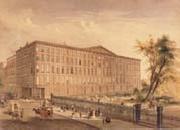 |
John William Hill 
|
|
English Painter, 1812-1879,Painter and illustrator, son of John Hill. At the age of seven he moved to Philadelphia, PA, with his family. In 1822 he moved to New York, where he was apprenticed to his father for seven years. During this time, he worked on the aquatint plates for William Guy Wall's Hudson River Portfolio (1821-5), which influenced his early paintings.
|
|
 |
John William Inchbold 
|
|
1830-1888
English painter. He spent his early years in Leeds, where his father was a newspaper proprietor, but came to London around 1846 to study lithography in the firm of Day & Haghe. His obituary in The Athenaeum records that he went on to study at the Royal Academy Schools, but his name does not appear in the registers. He exhibited watercolours at the Society of British Artists in 1849 and 1850 and at the Royal Academy in 1851. At this period his work has a fluidity and a freedom of handling that is closer to Richard Parkes Bonington than to the prevailing style of Victorian watercolours. Around 1852 he came under the influence of the Pre-Raphaelite movement and radically altered his style. His oil painting of the Chapel, Bolton (exh. RA 1853; Northampton, Cent. Mus. & A.G.) is a meticulously rendered view of the abbey ruins in the Pre-Raphaelite manner. This was followed the next year by At Bolton (Leeds, C.A.G.), another view of Bolton Abbey, this time with a deer prominent in the foreground. Both paintings illustrate lines from William Wordsworth's poem 'The White Doe of Ryleston'. Wordsworth was also the inspiration for the small painting Study in March
|
|
 |
John William North,ARA 
|
|
1842-1924
|
|
 |
John William North,ARA,RWS 
|
|
1842-1924
|
|
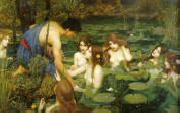 |
John William Waterhouse 
|
|
English Pre-Raphaelite Painter, 1849-1917
English painter. His father was a minor English painter working in Rome. Waterhouse entered the Royal Academy Schools in London in 1870. He exhibited at the Society of British Artists from 1872 and at the Royal Academy from 1874. From 1877 to the 1880s he regularly travelled abroad, particularly to Italy. In the early 1870s he had produced a few uncharacteristic Orientalist keepsake paintings, but most of his works in this period are scenes from ancient history or classical genre subjects, similar to the work of Lawrence Alma-Tadema (e.g. Consulting the Oracle, c. 1882; London, Tate). However, Waterhouse consistently painted on a larger scale than Alma-Tadema. His brushwork is bolder, his sunlight casts harsher shadows and his history paintings are more dramatic.
|
|
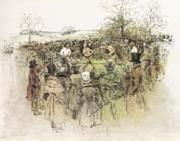 |
John Wolcott Adams 
|
|
American Illustrator
1874-1925
|
|
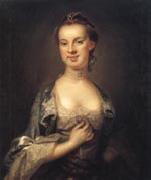 |
John Wollaston 
|
|
English-born American Rococo Era Painter, active 1742-1775
|
|
 |
John Wootton 
|
|
1682 - 1764
English painter. He probably received some instruction from Jan Wyck in the 1690s, and he was possibly patronized from an early age by the aristocratic households of Beaufort and Coventry (as was Wyck), perhaps while working as a page to Lady Anne Somerset at Snitterfield House, Warwicks. However, there seems to be no real evidence for this save his early painted view of the house and the family's later acquisition of many of his works. Joseph Farington saw a painting of Diana and the Nymphs (1707; untraced) at Antony House, Cornwall, but Wootton's earliest extant dated work is the horse portrait Bonny Black (1711; Belvoir Castle, Leics). By this time he had begun to establish himself in London, having moved there before his first marriage, to Elizabeth Walsh, in 1706.
|
|
 |
johnwilliam waterhouse,R.A. 
|
|
English Pre-Raphaelite Painter, 1849-1917
|
|
 |
Joos van Winghe 
|
|
(1544, Brussels - 1603, Frankfurt), was a Flemish Renaissance painter.
According to Karel van Mander he was born in Brussels in 1544 and travelled to Rome where he lived with a Cardinal for four years. When he returned to Brussels he became court painter to the Prince of Parma until he left the country in 1584 as a consequence of the Fall of Antwerp. He settled in Frankfurt and his place at Parma's court was taken by Otto van Veen. He died in 1603, aged 61. Van Mander mentions several pieces by his hand in Brussels, Frankfurt, and Amsterdam.
According to the RKD who spent four years travelling in Rome, Parma, and Paris before returning to Brussels in 1568. In 1585 he moved to Frankfurt, where he became a citizen (burgher) in 1588 and stayed. He was the father of the painter Jeremias van Winghe, and is known for portraits and genre works, as well as book title pages.
|
|
 |
Josef Wilhelm Wallander 
|
|
1821-1888
|
|
 |
Joseph Mallord William Truner 
|
|
born: London, England; 23 April 1775 died: London, England; 19 December
1851.
|
|
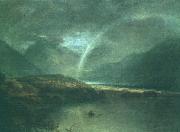 |
Joseph Mallord William Turner 
|
|
English Romantic Painter, 1775-1851
Joseph Mallord William Turner (23 April 1775 ?C 19 December 1851) was an English Romantic landscape painter, watercolourist and printmaker, whose style is said to have laid the foundation for Impressionism. Although Turner was considered a controversial figure in his day, he is now regarded as the artist who elevated landscape painting to an eminence rivalling history painting.
Turner's talent was recognised early in his life. Financial independence allowed Turner to innovate freely; his mature work is characterised by a chromatic palette and broadly applied atmospheric washes of paint. According to David Piper's The Illustrated History of Art, his later pictures were called "fantastic puzzles." However, Turner was still recognised as an artistic genius: the influential English art critic John Ruskin described Turner as the artist who could most "stirringly and truthfully measure the moods of Nature." (Piper 321)
Suitable vehicles for Turner's imagination were to be found in the subjects of shipwrecks, fires (such as the burning of Parliament in 1834, an event which Turner rushed to witness first-hand, and which he transcribed in a series of watercolour sketches), natural catastrophes, and natural phenomena such as sunlight, storm, rain, and fog. He was fascinated by the violent power of the sea, as seen in Dawn after the Wreck (1840) and The Slave Ship (1840).
Turner placed human beings in many of his paintings to indicate his affection for humanity on the one hand (note the frequent scenes of people drinking and merry-making or working in the foreground), but its vulnerability and vulgarity amid the 'sublime' nature of the world on the other hand. 'Sublime' here means awe-inspiring, savage grandeur, a natural world unmastered by man, evidence of the power of God - a theme that artists and poets were exploring in this period. The significance of light was to Turner the emanation of God's spirit and this was why he refined the subject matter of his later paintings by leaving out solid objects and detail, concentrating on the play of light on water, the radiance of skies and fires. Although these late paintings appear to be 'impressionistic' and therefore a forerunner of the French school, Turner was striving for expression of spirituality in the world, rather than responding primarily to optical phenomena.
Rain, Steam and Speed - The Great Western Railway painted (1844).His early works, such as Tintern Abbey (1795), stayed true to the traditions of English landscape. However, in Hannibal Crossing the Alps (1812), an emphasis on the destructive power of nature had already come into play. His distinctive style of painting, in which he used watercolour technique with oil paints, created lightness, fluency, and ephemeral atmospheric effects. (Piper 321)
One popular story about Turner, though it likely has little basis in reality, states that he even had himself "tied to the mast of a ship in order to experience the drama" of the elements during a storm at sea.
In his later years he used oils ever more transparently, and turned to an evocation of almost pure light by use of shimmering colour. A prime example of his mature style can be seen in Rain, Steam and Speed - The Great Western Railway, where the objects are barely recognizable. The intensity of hue and interest in evanescent light not only placed Turner's work in the vanguard of English painting, but later exerted an influence upon art in France, as well; the Impressionists, particularly Claude Monet, carefully studied his techniques.
|
|
 |
Joseph Whiting Stock 
|
|
1815-1855
American painter. He was physically handicapped and confined to his house until his doctor advised a wheelchair, which, when placed on a railway carriage, allowed him to travel. He took painting lessons as therapy from Franklin White, a pupil of Chester Harding, and became proficient as an artist. This enabled him to make a living painting portraits, landscapes and miniatures throughout New England and part of New York State. He kept a journal that lists 912 examples of his work executed between 1832 and 1846, with the names of his sitters, canvas sizes, the prices charged and where the pictures were painted. No examples of his landscapes have survived and only a few of his 80 miniatures have been located. The earliest miniatures date from 1836, but most were executed in 1842 and 1845 when he lived in New Bedford, MA. Few American primitive artists of the 19th century were as productive as Stock.
|
|
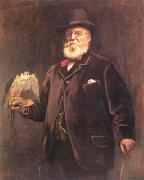 |
Joseph Wolf 
|
|
(January 22, 1820 - April 20, 1899) was a German artist who specialized in natural history illustration. He moved to the British Museum in 1848 and became the choice of illustrator for numerous explorers and collectors. He depicted animals accurately in life-like postures and has been considered one of the great pioneers of wildlife art. Sir Edwin Landseer considered him ...without exception, the best all-round animal artist who ever lived.
Wolf was the son of a farmer, and was born in Mörz near Menstermaifeld, not far from the river Moselle, in the Eifel region. In his boyhood he was an assiduous student of bird and animal life, and showed a remarkable capacity as a draughtsman of natural history subjects.
At the age of sixteen he went to Koblenz to work for a firm of lithographers, and then in 1840 he moved to Frankfurt. Here he provided the illustrations for Eduard Reppell's Birds of Northeast Africa.
|
|
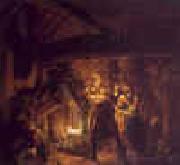 |
Joseph Wright 
|
|
1734-1797
British
Joseph Wright Gallery
English painter. He painted portraits, landscapes and subjects from literature, but his most original and enduringly celebrated works are a few which reflect the philosophical and technological preoccupations of the later 18th century and are characterized by striking effects of artificial light. He was the first major English painter to work outside the capital all his life: apart from spells in Liverpool (1768-71), Italy (1773-5) and Bath (1775-7), he lived and worked in his native Derby, though exhibiting in London at both the Society of Artists (1765-76, 1791) and the Royal Academy (1778-82, 1789-90, 1794
|
|
 |
Joseph wright of derby 
|
|
1734-97
English painter. He painted portraits, landscapes and subjects from literature, but his most original and enduringly celebrated works are a few which reflect the philosophical and technological preoccupations of the later 18th century and are characterized by striking effects of artificial light. He was the first major English painter to work outside the capital all his life: apart from spells in Liverpool (1768-71), Italy (1773-5) and Bath (1775-7), he lived and worked in his native Derby, though exhibiting in London at both the Society of Artists (1765-76, 1791) and the Royal Academy (1778-82, 1789-90, 1794).
|
|
 |
julian alden weir 
|
|
American Impressionist Painter, 1852-1919
.American painter. He studied with his father Robert Walter Weir, a landscape painter of the Hudson River school, at the National Academy; and with Görôme in Paris. He was one of the earliest American impressionist painters. Subtle gradations of light and tone characterize his work. He was a founder of the Society of American Artists (1877), a member of the National Academy (1886), and its president (1915 C17). When the Ten American Artists formed a separate group (1898), he joined them. His works include Idle Hours, The Green Bodice, and The Red Bridge; a portrait and Autumn ; and Midday Rest in New England.
|
|
 |
Julie Wilhelmine Hagen-Schwarz 
|
|
(born October 27, 1824 near Tartu - died Tartu October 7, 1902) was an Estonian painter of Baltic German origin. She studied in Dresden with Friedrich Gonne and later in Munich with Johann Moritz Rugendas.
|
|
 |
KALF, Willem 
|
|
Dutch Baroque Era Painter, ca.1622-1693
|
|
 |
Karl Ferdinand Wimar 
|
|
(also known as Charles Wimar and Carl Wimar) (1828-1862), was a German-American painter who concentrated on Native Americans in the West and the great herds of buffalo.
He is known for an early painting of a colonial incident: his The Abduction of Boone's Daughter by the Indians (1855-1856), a depiction of the 1776 capture near Boonesborough, Kentucky of Jemima Boone and two other girls by a Cherokee-Shawnee raiding party.
|
|
 |
Karl Friedrich Christian Welsch 
|
|
German, 1828 - 1904
|
|
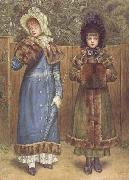 |
Kate Greenaway,RWS,RI 
|
|
1846-1901
English painter, illustrator and writer. The daughter of a Fleet Street wood-engraver, John Greenaway (1818-90), she trained at Islington School of Art, Heatherleys Academy and the Slade School of Fine Art, all in London. In 1868 she did her first commercial work, producing Christmas and Valentine cards for Marcus Ward, Belfast.
|
|
 |
Kazimierz Wojniakowski 
|
|
(1771-1812) was a Polish painter.
Wojniakowski was a pupil of Marcello Bacciarelli.
His work as a portraitist was influenced by that of the Polish painter Jezef Grassi, as in Wojniakowski's 1796 Portrait of Izabela Czartoryska, nee Fleming.
Other note-worthy portraits by Wojniakowski include his portrait of Tadeusz Kościuszko.
Wojniakowski also produced religious works and scenes of contemporary historic events (e.g., The Constitution of May 3, 1791, 1806).
Notable as well are Wojniakowski's drawings from journeys, e.g. in Lublin Province.
|
|
 |
Krishna Raja Wadiyar IV 
|
|
Krishna Raja Wadiyar IV (June 4, 1884 - August 3, 1940, Bangalore Palace), also known popularly as Nalwadi Krishna Raja Wadiyar was the ruling Maharaja of the princely state of Mysore from 1902 until his death in 1940. He is regarded as one of the most celebrated rulers among the Indian States when India was still under British rule. At the time of his death, he was also one of the world's wealthiest men, with a personal fortune estimated in 1940 to be worth $400 million which would be equivalent to $56 billion in 2010 prices.
|
|
 |
Kuhn Walt 
|
|
American cartoonist and painter,
1877-1949
was an American painter and was an organizer of the modern art Armory Show of 1913, which was the first of its genre in America. Kuhn was born in Brooklyn, New York City. At 15, Kuhn sold his first drawings to a magazine and signed his name ??Walt.?? In 1893, he enrolled in art classes at the Brooklyn Polytechnic Institute. In 1899, Kuhn set out for California with only $60 in his pocket. Upon his arriving in San Francisco, he became an illustrator for WASP Magazine. In 1901, Walt left for Paris, where he briefly studied art at the Acad??mie Colarossi before leaving to the Royal Academy in Munich. Once in the capital of Bavaria, he studied under Heinrich von Zugel (1850-1941), a member of the Barbizon School. In 1903, he returned to New York and was employed as an illustrator for local journals. In 1905, he held his first exhibition at the Salmagundi Club, establishing himself as both a cartoonist and a serious painter. In this same year, he completed his first illustrations for LIFE magazine. When the New York School of Art moved to Fort Lee, NJ in the summer of 1908, Kuhn joined the faculty.
|
|
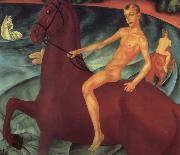 |
Kusma Petrow-Wodkin 
|
|
1878-1939
|
|
 |
Larkin, William 
|
|
British Painter, ca.1580-1619
|
|
 |
Leibl, Wilhelm 
|
|
German Realist Painter, 1844-1900
German painter, draughtsman and etcher. In 1861 he abandoned his apprenticeship as a locksmith in order to train as a precision instrument maker, though a month or so later he decided to train as an artist, at first under the Cologne history painter and writer Hermann Becker (1817-85). In 1863 he moved to Munich; he studied there from March 1864, at the Akademie der Bildenden K?nste, initially under Philipp von Foltz and Alexander Straehuber, drawing from plaster casts, and later in Hermann Ansch?tz's painting class. Here, Arthur von Ramberg (1819-75) stimulated Leibl's sensitivity to colour; and Karl Theodor von Piloty encouraged him to observe reality and incorporate its lessons boldly into compositions on historical themes. From the start, however, Leibl tended to think of his pictures in terms of form rather than content. While at the Akademie he first reached a standard of excellence with his draughtmanship, which is notable for its directness and objectivity. As an artist, Leibl's early works were not especially promising. However, as occurred throughout his career, a long period of mediocrity was crowned by an unexpected masterpiece, such as his portrait drawing of Aunt Josepha (c. 1864; Cologne, Wallraf-Richartz-Mus.). This is particularly striking for Leibl's use of the hands to add to the expression of the sitter's character and mood, a device he was to use frequently in later work. In Munich, Leibl supplemented the teaching of the Akademie by studying the works of the Old Masters in the Alte Pinakothek: he paid particular attention to painters of the Baroque period such as van Dyck, Cornelis de Vos and Rubens, and also to other great masters of portraiture such as Frans Hals and Vel?zquez. The presentation of the subject found in such works is reflected in Leibl's portrait of Frau Gedon (1869; Munich, Neue Pin.). When the work was shown at the Grossen Internationale Kunstausstellung in Munich in 1869 it was singled out as the best oil painting of the exhibition by Gustave Courbet and, as a result, Leibl was honoured with an invitation to Paris, where he arrived on 13 November 1869.
|
|
 |
Leslie Ward 
|
|
British Illustrator caricaturist and portrait painter , (1851-1922),
was a British portrait artist and caricaturist who drew or painted numerous portraits which were regularly published by Vanity Fair, under the pseudonym "Spy". Ward was one of eight children of artists Edward Matthew Ward and Henrietta Ward, and the great-grandson of the artist James Ward. Although they had the same surname before marriage, Ward's parents were not related. Both were well-known history painters, his mother coming from a line of painters and engravers, including her father, the engraver and miniature painter George Raphael Ward, and her grandfather, the celebrated animal painter James Ward. She was niece and great-niece respectively of the portrait painter John Jackson and the painter George Morland. Both parents had studios in their homes in Slough in Buckinghamshire and Kensington in London, where they regularly entertained the London artistic and literary elite. Ward's father was a gifted mimic who entertained Charles Dickens and other eminent guests. Although they never gave their son formal training, they and their artistic friends encouraged the young Ward to draw, paint, and sculpt.[1] Ward had started caricaturing while still at school at Eton in Windsor, using his classmates and school masters as subjects. In 1867 his bust of his brother was exhibited at the Royal Academy in London. At school Ward had been an unexceptional student, and after he left Eton in 1869 his father encouraged him to train as an architect. Ward was too afraid to tell his father that he wanted to be an artist and he spent an unhappy year in the office of the architect Sydney Smirke, who was a family friend.
|
|
 |
Levi Wells Prentice 
|
|
1850-1935
Levi Wells Prentice Gallery
Prentice was associated with the Hudson River School, a group of artists known throughout art circles. According to the book Nature Staged by Barbara Jones, Prentice followed a self-prescribed educational path, begun by the Hudson River School and reinforced by John Ruskin's (1819-1900) truth-to-nature principles laid out in his book Modern Painters. Although he can be allied to both schools of thought, Prentice can not be considered a member of either. This book has a photo of the artist in his early Brooklyn studio surrounded by his paintings and a complete essay on his life and work.
Levi grew up on a farm in Lewis County, New York. By 1872, Prentice had traveled through the Adirondack Mountains, painting the views as well as the surrounding region. He opened his first studio as a landscape painter in Syracuse, New York in 1875.
Self-taught artist Levi Wells Prentice is best known for his realistic still life compositions of fruit arranged within a landscape, or abundantly spilling from bushel baskets. Early in his career, he painted portraits and landscapes of the Adirondack Mountain region of Lewis County, New York, his birthplace.
Levi married an English woman Emma Roseloe Sparks in Buffalo, New York in 1882 and had two children, Leigh (born 22 March 1887) and Imogene (born 17 September 1889).
Prentice then turned to painting still life subjects when he moved briefly to Brooklyn, New York in 1883, focusing on fruit, in order of frequency apples, strawberries, peaches, plums, raspberries, cherries, muskmelons, pears, currants, pineapples, gooseberries, grapes and bananas usually piled high in pots or in natural settings.
Prentice subsequently moved around from 1903-07 before settling in the Germantown district of Philadelphia. However, his work did not gain much recognition with historians until the 1970s. He was a member of the Brooklyn Art Association and frequently exhibited his paintings there.
In addition to his artistic talents, he was a craftsman who enjoyed making his own brushes, palettes and frames.
In his painting, Prentice placed an emphasis on dark outlining with a concern for textual precision, creating dramatic contrasts. The shift between dark background areas and the vibrant hues of the fruit are done to give the compositions an exciting, visual energy. The fruit is presented with clarity and precision. An emphasis appears to be placed on the idea of man versus nature. The wooden baskets with hand-wrought nails represent a structured, man-made object, while the overly ripe fruit represents the fleeting qualities of nature. These paintings also demonstrate Prentice's remarkable skills at rendering color, form, and texture.
Noted art historian William H. Gerdts observed: there are several works by Prentice in which he achieves a quality of illusionism which is unsurpassed. In 1993, the skillful 'illusionism' of Levi Wells Prentice was celebrated in a retrospective exhibition at the Adirondack Museum in New York. His works continue to receive a high degree of appreciation by collectors today. He is represented in many museums including the New York State Museum, Museum of Fine Arts, Boston, Montclair Art Museum, Philbrook Museum of Art and Yale University Art Gallery.
Levi died 28 November 1935 in Germantown, Pennsylvania.
|
|
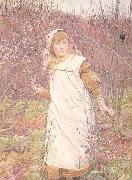 |
Lionel Percy Smythe,RA,RWS 
|
|
1839-1918
|
|
 |
Lionel Walden 
|
|
(1861-1933) was born in Norwich, Connecticut in 1861. He first became interested in art in Minnesota, where the family moved when his father became rector of an Episcopal Church there. As a young man, Walden moved to Paris where he studied painting with Carolus-Duran. In around 1893-97, Walden was in England, living in Falmouth. Paintings of Cardiff in Wales are in museums in Cardiff and Paris. Walden received medals from the Paris Salon and was made a Knight of the French Legion of Honor. He visited to Hawaii in 1911 and several times thereafter. Walden died in Chantilly, France in 1933.
According to David H. Forbes, author of Encounters with Paradise: Views of Hawaii and its People, 1778-1941, Lionel Walden "was the finest seascape painter to work in Hawaii". The Brooklyn Museum, the Henry Art Gallery (University of Washington, Seattle), the Honolulu Academy of Arts, the Isaacs Art Center (Waimea, Hawaii), and the Musee d'Orsay are among the public collections holding works by Lionel Walden.
|
|
 |
Louis Gallait 
|
|
(9 or 10 May 1810 - 20 November 1887) was a Belgian painter. His d his reputation especially with the large painting of Charles V's abdication. Gallait's works were considered as the basis for a desirable renewal of historical paintings because of the realism, costume faithfulness and colorful posture of his paintings. His last artwork was sent on tour in Germany and that led to new signals even among German historians. He was also a distinguished portrait painter.
Gallait died in Brussels in 1887. There is a painting by Louis Gallait at the Norton Art Museum in West Palm Beach, Florida ("Art and Liberty").
|
|
 |
Louis Welden Hawkins 
|
|
British
1849-1910
Louis Welden Hawkins Galleries
Louis Welden Hawkins was born in Germany ( 1 July 1849 ). His mother was an Austrian Baroness, his father Englishman. Hawkins moved soon to France and took later French nationality. Hawkins attended the famous Acad??mie Julian in Paris. Hawkins became famous after his expositions in the Salon de la Societe des Artistes Francais. His first work was shown in the Salon in 1881. After that, expositions followed at the Salon de la Societe des Beaux Artes (1894-1911), the Salon de la Rose-Croix (1894-95) and La Libre Esthetque in Brussels. He spended his last years in Brittany, where he painted mostly landscapes.
Louis Welden Hawkins died in 1910 and was honoured a year later at the Salon Nationale.
|
|
 |
MacLeod, William Douglas 
|
|
American, 1811-92
|
|
 |
Maria Catharina Wiik 
|
|
(b Helsinki, 2 Aug 1853; d Helsinki, 19 June 1928). Finnish painter. She studied in Paris at the Academie Julian from 1875 to 1876 under Tony Robert-Fleury and continued her studies with him in the same studio between 1877 and 1880. Her paintings appeared at the Salon for the first time in 1880 (e.g. Marietta, 1880; Helsinki, priv. col., see Katerma, p. 31). The realist techniques Wiik absorbed in Paris came to form the basis of her work, tranquil in composition and restrained in colour. Her favourite subjects were relatively small-scale portraits such as Hilda Wiik (1881; Helsinki, Athenaeum A. Mus.) and still-lifes (e.g. Still-life, c. 1880; Helsinki, Athenaeum A. Mus.). Like many other foreign painters Wiik went to Brittany to paint. In 1883-4 she worked in Concarneau and Pont-Aven, where her enthusiasm for plein-air painting brought immediacy to her work and greater brightness to her colours (e.g. Breton Farm, 1883; Naantali, Fereningen Hedvigsminne). She preferred to record her impressions in portraits, although she also painted small, light-filled landscapes. In 1889 Wiik worked under the direction of Puvis de Chavannes in Henri Bouvet's studio in Paris, and in the same year she visited St Ives where she painted, among others, two major works: Out in the World (Helsinki, Athenaeum A. Mus.) and the St Ives Girl (Helsinki, priv. col., see Katerma, p. 93). Both works show Wiik moving towards an ever more internalized and minimal mode of expression, thereby taking part in the process that led, in the 1890s, to a general abandonment of realism in favour of a greater emphasis on emotion. Out in the World, which shows an old woman's sad parting from a young girl who is leaving home to begin work, shows a change in technique with the use of more united colour surfaces and of tone painting. (This work was awarded a bronze medal at the Exposition Universelle in Paris in 1900.) During the 1890s and the early 20th century Wiik's travels were concentrated in Scandinavia, although she visited Paris in 1905.
|
|
 |
Marianne von Werefkin 
|
|
Marianne von Werefkin (Russian, 10 September 1860, Tula, Russia - 6 February 1938, Ascona, Switzerland), born Marianna Wladimirowna Werewkina (transliteration Marianna Vladimirovna Verevkina), was a Russian-Swiss Expressionist painter.
Marianne von Werefkin was born the daughter of the commander of the Ekaterinaburg Regiment. In 1880, she became a student of Ilya Repin, the most important painter of Russian Realism. Her progress was dealt a setback by a hunting accident in 1888 in which she shot her right hand, the one with which she painted.
In 1892 she met Alexej von Jawlensky, who desired to be her protege, and in 1896 she, Jawlensky, and their servant moved to Munich. For the sake of Jawlensky's painting, Werefkin interrupted her painting for almost ten years.
She created her first expressionist works in 1907. In these she followed Paul Gauguin's and Louis Anquetin's style of "surface painting", while also showing the influence of Edvard Munch. In 1909, the Neue Kenstlervereinigung Menchen (New Association of Artists in Munich, NKVM) was founded. It became a forum of exhibitions and programming.
At the outbreak of the First World War, they immigrated to Switzerland, near Geneva. They later moved to Zurich. By 1918, they had separated, and Werefkin moved alone to Ascona, on Lago Maggiore. In 1924 she founded the artist group "Grober Bar" (i.e., Big Bear, Ursa Major).
|
|
 |
Marie Wiegmann 
|
|
painted Mrs. Carl vom Rath in 1866
|
|
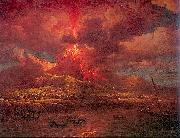 |
Marlow, William 
|
|
English, 1740-1813
English painter. From c. 1756 to 1761 he was a pupil of Samuel Scott, the topographical and marine painter; he also studied at the St Martin's Lane Academy, London. Throughout his career Marlow made oils and watercolours of London views, for example Near Westminster Bridge, Evening (London, Guildhall A.G.), which shows his balanced, classical sense of composition, sensitivity to lighting effects and smooth handling of oil paint. Between 1765 and 1766 Marlow travelled in France and Italy, making numerous drawings of ruins, which provided the subjects for many paintings finished on his return to London. An Oxcart in the Grotto of Posillipo (c. 1770; New Haven, CT, Yale Cent. Brit. A.) exemplifies his bold, blue-toned watercolour style, with washes applied in loose blotches to emphasize the picturesque roughness of masonry and terrain. The handling has much in common with Canaletto, whom Marlow copied; a letter of 1771 from Horace Walpole to Sir Horace Mann (see 1956 exh. cat., p. 3) records that two views of Verona by Marlow were mistakenly sold as Canalettos. Marlow specialized in souvenirs of the Grand Tour, portraits of country houses, seascapes and river scenes. He visited many parts of Britain and Ireland in search of subjects, such as Powys Castle, Montgomeryshire (U. Manchester, Whitworth A.G.).
|
|
 |
Marstrand, Wilhelm 
|
|
Danish, 1810-1873
Danish painter and illustrator. He was a student of C. W. Eckersberg at the Kunstakademi in Copenhagen (1825-33). His art reflects his constant observation of the world around him, in particular middle-class society, and the narrative element dominated his pictures of crowds in the city streets. Throughout his life he sought inspiration from literature and the theatre. In his early genre painting Moving Day Scene (1831; Niv?, Nivaagaards Malsaml.) it was the popular novelty of vaudeville that interested him. The October Festival (1839; Copenhagen, Thorvaldsens Mus.) reveals how Marstrand's five-year stay (1836-41) in Italy opened his eyes to the classical ideal of beauty. It was, however, an ideal that found little response in contemporary Denmark, and he turned towards a more anecdotal and humorous approach. In Scene of Country Life (1843; Copenhagen, Kon. Dan. Kstakad.), painted as a set subject for the Kunstakademi, Marstrand took as his theme a scene from Erasmus Montanus, a play by the 18th-century Danish poet and playwright Ludvig Holberg. Thereafter Holberg's comedies provided an inexhaustible source that satisfied Marstrand's need to pursue his investigations of human character. Family life similarly interested him throughout his career, as in his Scene of Daily Life (1857; Copenhagen, Stat. Mus. Kst). Such group portraits as The Waagepetersen Family (1836; Copenhagen, Stat. Mus. Kst) show an equal concern to depict the quiet details of Danish domestic life. Marstrand continued to travel abroad in search of inspiration. His stay in Venice in 1853-4 was particularly important; his studies there of the great Venetian painters improved his understanding of the handling of colour, as seen clearly in the many historical and religious paintings of his last years. Of particular interest is his mural decoration of Christian IV's chapel in Roskilde Cathedral (1864-6) with scenes from the life of the Danish monarch. Marstrand's paintings have a certain facetiousness which often obscures a much deeper philosophical content. For this reason, it is his drawings that arouse more admiration.
|
|
 |
Max Joseph Wagenbauer 
|
|
Maximilian Joseph Wagenbauer (1775 Grafing - 1829 Munich), was a Bavarian artist.
After finishing school, Wagenbauer attended drawing classes in Munich, under Johann Jakob Dorner the Elder (1741-1813). At the turn of the 19th century he was producing mostly Neo-Classical watercolour landscapes. He served in the military from 1797 to 1801, receiving a royal artist's annuity after his service through the influence of Johann Christian von Mannlich (1741-1822), architect and general building director of the dukes of Zweibre-ken. A condition of the royal stipend was that he produce paintings. He was appointed artist to the court and cabinet in 1802 and Inspector of the Royal Paintings Gallery in 1815. Wagenbauer focused increasingly on oil painting after 1810 and enjoyed the patronage of Maximilian I Joseph of Bavaria, who in 1811 commissioned him, Cantius Dillis (1779-1856) and Johann Jakob Dorner the Younger (1775-1852) to decorate the banquet hall at Schloss Nymphenburg with large paintings of Bavarian lakes.
|
|
 |
May Wilson Preston 
|
|
American , 1873-1949
|
|
 |
Metcalf, Willard Leroy 
|
|
American Impressionist Painter, 1858-1925
American painter and illustrator. His formal education was limited, and at 17 he was apprenticed to the painter George Loring Brown of Boston. He was one of the first scholarship students admitted to the school of art sponsored by the Museum of Fine Arts, Boston, and took classes there in 1877 and 1878. After spending several years illustrating magazine articles on the Zuni Indians of New Mexico, he decided to study abroad and in 1883 left for Paris. There he studied at the Acad?mie Julian under Jules Lefebvre and Gustave Boulanger. During the five years he spent in France he became intimately acquainted with the countryside around the villages of Grez-sur-Loing and Giverny. He returned to America in 1888
|
|
 |
Michael Willmann 
|
|
(27 September 1630 - 26 August 1706) was a German painter. The Baroque artist became known as the "Silesian Raphael".
Willmann was born in Königsberg, Duchy of Prussia. He was educated by his father, the painter, Christian Peter Willmann. Michael went to the Dutch Republic in 1650 to learn from the masters, and he was inspired by the works of Rembrandt, Peter Paul Rubens, and Anthony van Dyck. For financial reasons he was unable to afford studying at the studio of a well-known painter.
After two years in the Netherlands, mostly spent in Amsterdam, Willmann returned to Königsberg, passed his master's examination, and began to travel. After visiting Danzig, Willmann went to Prague, where he stayed from 1653-55. He then spent about a year in Breslau. Willmann's first known paintings, commissioned by Abbot Arnold Freiberger of the Abbatia Lubensis abbey in Leubus, Lower Silesia, date from 1656. Leubus became the setting of much of Willmann's creativity.
From 1657-58 Willmann was in Berlin as the court painter of Frederick William, Elector of Brandenburg. He painted mythological scenes for the elector, presumably for his residence at Königsberg Castle. In 1660 Willmann returned to Leubus, which allowed him a large workshop.
Willmann's workship, modeled after those of the Dutch painters, quickly spread his fame. The extensive studio included his son Michael Leopold Willmann the Younger, his daughter Anna Elisabeth, and Anna Elisabeth's husband Christian Neuenhertz and son Georg Wilhelm Neunhertz. Willmann's studio also counted Johann Kretschmer from Glogau, Johann Jacob Eybelwieser from Breslau, the Cistercian Jacob Arlet from Gressau, and Willmann's stepson Johann Christoph Lischka.
Willmann became the leading painter of Silesia through his expressiveness, technical dexterity, and speed. Willmann worked on orders from the patriciate of Breslau, as well as churches and monasteries throughout Silesia, Bohemia, and Moravia. He received contracts for the Cistercian monasteries in Gressau, Heinrichau, Kamenz, Rauden, and Himmelwitz. With the assistance of his students and assistants, Willmann produced 500 paintings and frescos during his life. Numerous drawings of Willmann's were later used by engravers.
|
|
 |
Michael Wolgemut 
|
|
German Northern Renaissance Painter and Printmaker, ca.1434-1519,German painter and printmaker, was born and died in Nuremberg.Little is known of Wolgemut's private life. He trained with his father Valentin Wolgemut (who died in 1469 or 1470) and in 1472 he married the widow of his former apprentice-master, the painter Hans Pleydenwurff, whose son Wilhelm worked as an assistant, and from 1491 a partner, to his stepfather. Some consider Wilhelm Pleydenwurff a finer artist than Wolgemut, however he died in January 1494, when he was probably still in his thirties. Wilhelm's oeuvre remains unclear, though works in various media have been attributed to him. The importance of Wolgemut as an artist rests, not only on his own individual works, but also on the fact that he was the head of a large workshop, in which many different branches of the fine arts were carried on by a great number of pupil-assistants, including Albrecht Durer, who completed an apprenticeship with him between 1486-9.
|
|
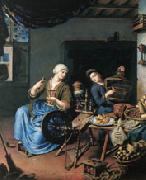 |
MIERIS, Willem van 
|
|
Dutch Baroque Era Painter , b. 1662, Leiden, d. 1747, Leiden, Dutch painter, was the son of Frans van Mieris sr.. His works are extremely numerous, being partly imitations of the paternal subjects, or mythological episodes, which Frans habitually avoided.
|
|
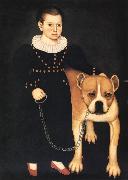 |
Milton William Hopkins 
|
|
American ,
b.1789 d.1844
|
|
|
|
|
|
|
|
|
| Wholesale China Oil Painting Wholesale Oil Painting China Xiamen Portrait Reproduction on canvas Chinese Oil Painting Wholesale USA Oil Painting |
|
|
|
|